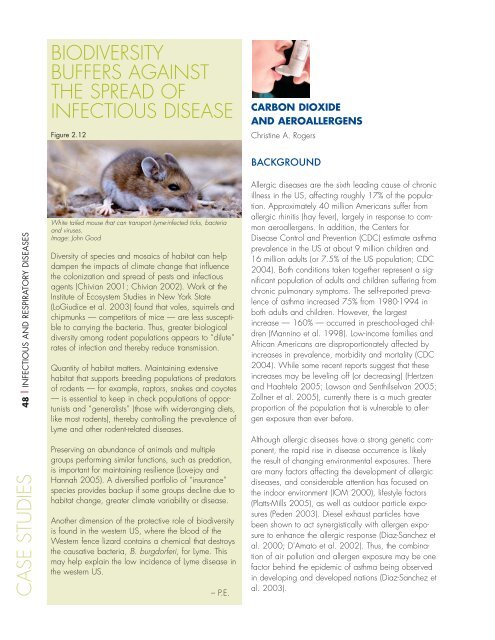Climate change futures: health, ecological and economic dimensions
Climate change futures: health, ecological and economic dimensions
Climate change futures: health, ecological and economic dimensions
You also want an ePaper? Increase the reach of your titles
YUMPU automatically turns print PDFs into web optimized ePapers that Google loves.
BIODIVERSITY<br />
BUFFERS AGAINST<br />
THE SPREAD OF<br />
INFECTIOUS DISEASE<br />
Figure 2.12<br />
CARBON DIOXIDE<br />
AND AEROALLERGENS<br />
Christine A. Rogers<br />
BACKGROUND<br />
48 | INFECTIOUS AND RESPIRATORY DISEASES<br />
CASE STUDIES<br />
White tailed mouse that can transport Lyme-infected ticks, bacteria<br />
<strong>and</strong> viruses.<br />
Image: John Good<br />
Diversity of species <strong>and</strong> mosaics of habitat can help<br />
dampen the impacts of climate <strong>change</strong> that influence<br />
the colonization <strong>and</strong> spread of pests <strong>and</strong> infectious<br />
agents (Chivian 2001; Chivian 2002). Work at the<br />
Institute of Ecosystem Studies in New York State<br />
(LoGiudice et al. 2003) found that voles, squirrels <strong>and</strong><br />
chipmunks — competitors of mice — are less susceptible<br />
to carrying the bacteria. Thus, greater biological<br />
diversity among rodent populations appears to “dilute”<br />
rates of infection <strong>and</strong> thereby reduce transmission.<br />
Quantity of habitat matters. Maintaining extensive<br />
habitat that supports breeding populations of predators<br />
of rodents — for example, raptors, snakes <strong>and</strong> coyotes<br />
— is essential to keep in check populations of opportunists<br />
<strong>and</strong> “generalists” (those with wide-ranging diets,<br />
like most rodents), thereby controlling the prevalence of<br />
Lyme <strong>and</strong> other rodent-related diseases.<br />
Preserving an abundance of animals <strong>and</strong> multiple<br />
groups performing similar functions, such as predation,<br />
is important for maintaining resilience (Lovejoy <strong>and</strong><br />
Hannah 2005). A diversified portfolio of “insurance”<br />
species provides backup if some groups decline due to<br />
habitat <strong>change</strong>, greater climate variability or disease.<br />
Another dimension of the protective role of biodiversity<br />
is found in the western US, where the blood of the<br />
Western fence lizard contains a chemical that destroys<br />
the causative bacteria, B. burgdorferi, for Lyme. This<br />
may help explain the low incidence of Lyme disease in<br />
the western US.<br />
– P.E.<br />
Allergic diseases are the sixth leading cause of chronic<br />
illness in the US, affecting roughly 17% of the population.<br />
Approximately 40 million Americans suffer from<br />
allergic rhinitis (hay fever), largely in response to common<br />
aeroallergens. In addition, the Centers for<br />
Disease Control <strong>and</strong> Prevention (CDC) estimate asthma<br />
prevalence in the US at about 9 million children <strong>and</strong><br />
16 million adults (or 7.5% of the US population; CDC<br />
2004). Both conditions taken together represent a significant<br />
population of adults <strong>and</strong> children suffering from<br />
chronic pulmonary symptoms. The self-reported prevalence<br />
of asthma increased 75% from 1980-1994 in<br />
both adults <strong>and</strong> children. However, the largest<br />
increase — 160% — occurred in preschool-aged children<br />
(Mannino et al. 1998). Low-income families <strong>and</strong><br />
African Americans are disproportionately affected by<br />
increases in prevalence, morbidity <strong>and</strong> mortality (CDC<br />
2004). While some recent reports suggest that these<br />
increases may be leveling off (or decreasing) (Hertzen<br />
<strong>and</strong> Haahtela 2005; Lawson <strong>and</strong> Senthilselvan 2005;<br />
Zollner et al. 2005), currently there is a much greater<br />
proportion of the population that is vulnerable to allergen<br />
exposure than ever before.<br />
Although allergic diseases have a strong genetic component,<br />
the rapid rise in disease occurrence is likely<br />
the result of changing environmental exposures. There<br />
are many factors affecting the development of allergic<br />
diseases, <strong>and</strong> considerable attention has focused on<br />
the indoor environment (IOM 2000), lifestyle factors<br />
(Platts-Mills 2005), as well as outdoor particle exposures<br />
(Peden 2003). Diesel exhaust particles have<br />
been shown to act synergistically with allergen exposure<br />
to enhance the allergic response (Diaz-Sanchez et<br />
al. 2000; D'Amato et al. 2002). Thus, the combination<br />
of air pollution <strong>and</strong> allergen exposure may be one<br />
factor behind the epidemic of asthma being observed<br />
in developing <strong>and</strong> developed nations (Diaz-Sanchez et<br />
al. 2003).

















